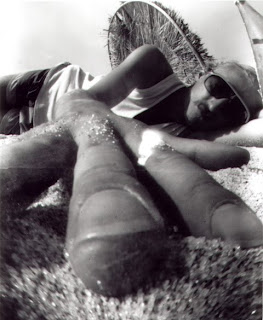 "An artist is somebody who produces things that people don’t need to have" - Andy Warhol
"An artist is somebody who produces things that people don’t need to have" - Andy WarholI have never seen much in the way of advertising for the Guy Pearce / Sienna Miller release, Directed by George Hickenlooper. Released in 2006, it seemed to take a bit of a back seat from the limelight. Somewhat ironic considering the glitzed up content, Pearce's Andy Warhol Sasheying on and off screen combined with Miller's Edie Sedgwick jumping, bumping and rolling throughout the entire plot, if you can indeed call it a plot. The length of the feature shows many of Warhols most famous works, with little or no hooks inbetween to make sense of time or date, documenting the artist that shook the world, and the muse who was dragged down through the weight of 'responsibility', and the obligatory drug use of course. This is a film that takes no prisoners.
The opening gambit portrayes the young Edies Sedgwick as a simple girl with big ideas of becoming an artist, but you quickly learn her childhood was not one to remenisce over. Millers first lines centre around the normal 'happy family' photographs you find donning the mantlepiece of many a home accross the world. 'I could never stand to even look at them. it just made me think, what secrets lay beneath this image'. So we have an image of the poor messed up kid, with no hope of living a normal life, as she is simply trying to escape from everything.
Warhol, on the other hand, is simply an idiot, or so it would seem. Maybe thats to harsh a word for him. He ceratinly isn't the genious everybody thinks, so the director or writers would suggest. The length of the film sees Warhol traipsing about with his Edie Sedgwick, latterly replaced by yet another striking bombshell, vaguely accounting for his art, in a way that presumes boredom and lack of real artistic insight. This is particularly apparent when Hayden Christiansen, playing Edie's Musician boyfriend, exposes the exploitative nature of Warhols filmic endeavours. "blood sucker" I believe was the term used. the very fact that warhol specialised in letting the actors in his films do what they wish is a blindingly obvious coherence with the musicians harsh words.
Interviewer: "some people say your films are pornographic"
Warhol: "oh year, isn't it great?"
The relationship between Edie Sedgwick and Andy Warhol itself is most poigniantly portrayed through a number of phonecalls, in which the couple discuss their lives, and how they will be remembered. throughout the text, you cannot help but feel sorry for the Edie who has grown so attached to Warhol, who displays fits of attachment, followed by bleak aspects of cold, harsh pacivity towards his blooming star. Her tragic demise is again pinned on the Warhols character, who is by this point beyond his emotive responses to her. His refusal to give money to any of his artists of actors is again a glaring attempt to pin Warhol down as the dominant vampire who fed off everyone around him, leaving nothing to keep for themselves. As Edie says Warhol was "throwing America back in its face...turning the assembly line into a punch line." and this apparently didnt stop with inanimate objects. If personification is the act of turning objects into people, he did the opposite, turning real people into an image for his blank canvas.
Aside from the underlying sense of foreboding and sadness you have for Edie, the intercut sections of 'swinging sixties' in all its glory serve to create a stark boundary between what everyone saw through the cathode rays, and the real life of the studio and the factory. Warhols presentation was only an elegant foray into the scenes of sexual deviance and artisitc seduction. Say what you like about Warhol, he knew exactly how to project a great image out of something America had come to take as a given. Casting a shiny gloss on what was seedy and normal, and selling it back to you for the cost of your soul.
This may seem a dramatic interpretation of a somewhat confused and sombre film, but it is one which I feel the director Hickenlooper and his writers were driving at. And to be honest, Warhol's pedestal is high enough for it to slip a few inches.

 The bizarre brain children of the Bristolian entrepeneur create an air of otherworldliness, such a key factor in their eyectaching simplicity. Voyeurs may feel very small when casting their eyes upon such wonderment.
The bizarre brain children of the Bristolian entrepeneur create an air of otherworldliness, such a key factor in their eyectaching simplicity. Voyeurs may feel very small when casting their eyes upon such wonderment.  The bizarre brain children of the Bristolian entrepeneur create an air of otherworldliness, such a key factor in their eyectaching simplicity. Voyeurs may feel very small when casting their eyes upon such wonderment.
The bizarre brain children of the Bristolian entrepeneur create an air of otherworldliness, such a key factor in their eyectaching simplicity. Voyeurs may feel very small when casting their eyes upon such wonderment. 




